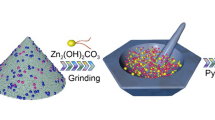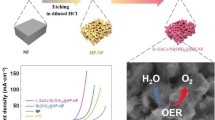Abstract
Over the past decades, a tremendous effort has been put into developing cost-effective and highly active electrocatalysts toward oxygen evolution reaction (OER) for proton exchange membrane water electrolyzer. This report explores a hard-template-assisted pyrolysis method to fabricate IrO2 electrocatalyst powders with hierarchically ordered porous structure. The effect of the calcination temperature on the pore structure and electrocatalytic property of periodically ordered macroporous IrO2 material is studied. XRD, BET, and SEM characterizations show that the templated IrO2 powders at 450 °C exhibit the honeycomb array of macropores with cross-linking mesopores on the pore walls. The calcination temperature above 450 °C will further lead to a growth of crystallite size and a loss of surface area. Once the calcination temperature exceeds 700 °C that is higher than the glass-transition temperature of the SiO2 template, the ordered porous structures of IrO2 material are prohibited from the formation. The templated IrO2 at 450 °C shows substantially reduced electrocatalytic overpotentials for the OER, i.e., the efficiency increases as compared with other samples treated at higher calcination temperatures. As compared with the untemplated IrO2 prepared by a simple pyrolysis method at 450 °C, the 3-DOM IrO2 (450 °C) exhibited more than 2 times enhancement in BET area, voltammetric charges, and OER activity. It clearly reveals the control effect of the pore structure on the surface catalytic properties of iridium oxide. The present method is effective in improving the utilization of precious metals.






Similar content being viewed by others
References
Liu X, Chang Z, Luo L, Xu T, Lei X, Liu J, Sun X (2014) Hierarchical ZnxCo3−xO4 nanoarrays with high activity for electrocatalytic oxygen evolution. Chem Mater 26:1889–1895
Carmo M, Fritz DL, Mergel J, Stolten D (2013) A comprehensive review on PEM water electrolysis. Int J Hydrog Energy 38:4901–4934
Parrondoa J, Argesa CG, Niedzwieckib M, Andersonb EB, Ayersb KE, Ramani V (2014) Degradation of anion exchange membranes used for hydrogen production by ultrapure water electrolysis. RSC Adv 4:9875–9879
Xu W, Scott K (2010) The effects of ionomer content on PEM water electrolyser membrane electrode assembly performance. Int J Hydrog Energy 35:12029–12037
Smith RDL, Sporinova B, Fagan RD, Trudel S, Berlinguette CP (2014) Facile photochemical preparation of amorphous iridium oxide films for water oxidation catalysis. Chem Mater 26:1654–1659
Lee WH, Kim H (2011) Oxidized iridium nanodendrites as catalysts for oxygen evolution reactions. Catal Commun 12:408–411
Sunde S, Lervik IA, Tsypkin M, Owe LE (2010) Impedance analysis of nanostructured iridium oxide electrocatalysts. Electrochim Acta 55:7751–7760
Adams R, Shriner RL (1923) Platinum oxide as a catalyst in the reduction of organic compounds. III. Preparation and properties of the oxide of platinum obtained by the fusion of chloroplatinic acid with sodium nitrate. J Am Chem Soc 45:2171–2179
Siracusano S, Van Dijk N, Payne-Johnson E, Baglio V, Aricò AS (2015) Nanosized IrOx and IrRuOx electrocatalysts for the O2 evolution reaction in PEM water electrolysers. Appl Catal B 164:488–495
Mattos-Costa FI, Lima-Neto PD, Machado S, Avaca L (1998) Characterisation of surfaces modified by sol-gel RuxIr1−xO2 coatings for oxygen evolution in acid medium. Electrochim Acta 44:1515–1523
Bonet F, Tekaia-Elhsissen K, Sarathy K (2000) Study of the interaction of ethylene glycol/PVP phase on noble metal powders prepared by polyol process. Bull Mater Sci 23:165–168
EI Sawy EN, Birss VI (2009) Nano-porous iridium and iridium oxide thin films formed by high efficiency electrodeposition. J Mater Chem 19:8244–8252
Li G, Yu H, Song W, Dou M, Li Y, Shao Z, Yi B (2012) A hard-template method for the preparation of IrO2, and its performance in a solid-polymer-electrolyte water electrolyzer. ChemSusChem 5:858–861
Ortel E, Reier T, Strasser P, Kraehnert R (2011) Mesoporous IrO2 films templated by PEO-PB-PEO block-copolymers: self-assembly, crystallization behavior, and electrocatalytic performance. Chem Mater 23:3201–3209
Hu J, Abdelsalam M, Bartlett P, Cole R, Sugawara Y, Baumberg J, Mahajanb S, Denuault G (2009) Electrodeposition of highly ordered macroporous iridium oxide through self-assembled colloidal templates. J Mater Chem 19:3855–3858
Zhang J, Tu JP, Cai GF, Du GH, Wang XL, Liu PC (2013) Enhanced electrochromic performance of highly ordered, macroporous WO3 arrays electrodeposited using polystyrene colloidal crystals as template. Electrochim Acta 99:1–8
Wang CH, Yang C, Song YY, Gao W, Xia XH (2005) Adsorption and direct electron transfer from hemoglobin into a three-dimensionally ordered macroporous gold film. Adv Funct Mater 15:1267–1275
Holland BT, Blanford CF, Stein A (1998) Synthesis of macroporous minerals with highly ordered three-dimensional arrays of spheroidal voids. Science 281:538–540
Holland BT, Blanford CF, Do T, Stein A (1999) Synthesis of highly ordered, three-dimensional, macroporous structures of amorphous or crystalline inorganic oxides, phosphates, and hybrid composites. Chem Mater 11:795–805
Chai GS, Shin IS, Yu JS (2004) Synthesis of ordered, uniform, macroporous carbons with mesoporous walls templated by aggregates of polystyrene spheres and silica particles for use as catalyst supports in direct methanol fuel cells. Adv Mater 16:2057–2061
Fang B, Kim JH, Kim M, Yu JS (2009) Ordered hierarchical nanostructured carbon as a highly efficient cathode catalyst support in proton exchange mem brane fuel cell. Chem Mater 21:789–796
Jiang F, Zheng T, Yang Y (2008) Preparation and electrochromic properties of tungsten oxide and iridium oxide porous films. J Non-Cryst Solids 354:1290–1293
Lee KT, Lytle JC, Ergang NS, Oh SM, Stein A (2005) Synthesis and rate performance of monolithic macroporous carbon electrodes for lithium-ion secondary batteries. Adv Funct Mater 15:547–556
Woo SW, Dokko K, Kanamura K (2007) Preparation and characterization of three dimensionally ordered macroporous Li4Ti5O12 anode for lithium batteries. Electrochim Acta 53:79–82
Hu W, Wang Y, Hu X, Zhou Y, Chen S (2012) Three-dimensional ordered macroporous IrO2 as electrocatalyst for oxygen evolution reaction in acidic medium. J Mater Chem 22:6010–6016
Stöber W, Fink A, Bohn E (1968) Controlled growth of monodispersed spheres in the micron size range. J Colloid Interface Sci 26:62–69
Minguzzi A, Fan FRF, Vertova A, Rondinini S, Bard AJ (2012) Dynamic potential–pH diagrams application to electrocatalysts for water oxidation. Chem Sci 3:217–229
Siracusano S, Baglio V, Di Blasi A, Briguglio N, Stassi A, Ornelas R, Trifoni E, Antonucci V, Arico AS (2010) Electrochemical characterization of single cell and short stack PEM electrolyzers based on a nanosized IrO2 anode electrocatalyst. Int J Hydrog Energy 35:5558–5568
Lodi G, Battisti AD (1990) Microstructure and electrical properties of IrO2 prepared by thermal decomposition of IrCl3·xH2O: role played by the conditions of thermal treatment. J Electroanal Chem 277:139–150
Lodi G, Battisti AD (1988) Formation of iridium metal in thermally prepared iridium dioxide coatings. J Electroanal Chem 256:441–445
Nanni L, Battisti AD, Daolio S, Facchin B, Paguera C (1995) Investigation of the Oxidative-Pyrolysis Processes of RuCl3·xH2O and IrCl3·xH2O. Mater Sci Forum 195:133–140
Hu W, Chen SL, Xia QH (2014) IrO2/Nb-TiO2 electrocatalyst for oxygen evolution reaction in acidic medium. Int Hydrog Energy 39:6967–6976
Marshall AT, Haverkamp RG (2010) Electrocatalytic activity of IrO2-RuO2 supported on Sb-doped SnO2 nanoparticles. Electrochim Acta 55:1978–1984
Fierro S, Ouattara L, Calderon EH, Comninellis C (2008) Influence of temperature on the charging/discharging process of IrO2 coating deposited on p-Si substrate. Electrochem Commun 10:955–959
Xu JY, Liu GY, Li JL, Wang XD (2012) The electrocatalytic properties of an IrO2/SnO2 catalyst using SnO2 as a support and an assisting reagent for the oxygen evolution reaction. Electrochim Acta 59:105–112
Li G, Yu H, Wang X, Yang D, Li Y, Shao Z, Yi B (2014) Triblock polymer mediated synthesis of Ir-Sn oxide electrocatalysts for oxygen evolution reaction. J Power Sources 249:175–184
Acknowledgements
This work was financially supported by the Ministry of Science and Technology of China (Grant Nos. 2012CB932800 and 2013AA110201), the National Natural Science Foundation of China (21073137), the Research Foundation of Education Bureau of Hubei Province, China (Grant No. Q20141007), and the Natural Science Fund for Creative Research Groups of Hubei Province of China (No. 2014CFA015).
Author information
Authors and Affiliations
Corresponding author
Rights and permissions
About this article
Cite this article
Hu, W., Zhou, P., Xu, S. et al. Template synthesis of 3-DOM IrO2 powder catalysts: temperature-dependent pore structure and electrocatalytic performance. J Mater Sci 50, 2984–2992 (2015). https://doi.org/10.1007/s10853-015-8863-x
Received:
Accepted:
Published:
Issue Date:
DOI: https://doi.org/10.1007/s10853-015-8863-x




